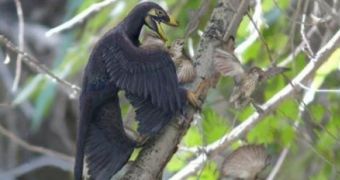An international team of researchers now say that, according to evidence at hand, continuous miniaturization explains how dinosaurs that roamed the Earth billions of years ago evolved into birds.
Thus, ancient beasts birthed birds by getting smaller and smaller as the millennia went by, and by developing anatomical particularities that enabled them to survive the meteorite crash that killed all other dinosaurs.
In a recent paper in the journal Science, specialists detail that, as shown by various analyses of fossilized remains unearthed over the years, modern birds evolved from a group of dinosaurs known as theropods.
Having examined well over 1,500 anatomical particularities of theropods that walked the Earth in different moments in our planet's history, researchers were able to put together a family tree for the branch that led to modern birds.
It was thus discovered that, when compared to their relatives, the dinosaurs that eventually evolved into birds shrank to a considerable extent over a period of time of approximately 50 million years, the Alpha Galileo Foundation informs.
This might sound like a whole lot of it, but the scientists who conducted this investigation argue that this shrinking process that turned rather big, meat-eating dinosaurs that lived on the ground into birds actually occurred at a surprisingly fast pace.
“Birds evolved through a unique phase of sustained miniaturisation in dinosaurs,” explains study lead author and associate professor Michael Lee with the University of Adelaide’s School of Earth and Environmental Sciences and the South Australian Museum.
“These bird ancestors also evolved new adaptations, such as feathers, wishbones and wings, four times faster than other dinosaurs,” add study co-author and vertebrate paleontologist Darren Naish with the University of Southampton in the United Kingdom.
It is believed that it was precisely because of their being smaller than their dinosaur relatives and because of their ability to change and adapt to new environmental conditions that birds managed to survive the meteorite crash that reshaped Earth's biodiversity millions of years ago.
“Being smaller and lighter in the land of giants, with rapidly evolving anatomical adaptations, provided these bird ancestors with new ecological opportunities, such as the ability to climb trees, glide and fly. Ultimately, this evolutionary flexibility helped birds survive the deadly meteorite impact which killed off all their dinosaurian cousins.”
“Birds out-shrank and out-evolved their dinosaurian ancestors, surviving where their larger, less evolvable relatives could not,” University of Adelaide specialist Michael Lee sums up the findings of this investigation into the lineage of modern birds.

 14 DAY TRIAL //
14 DAY TRIAL //